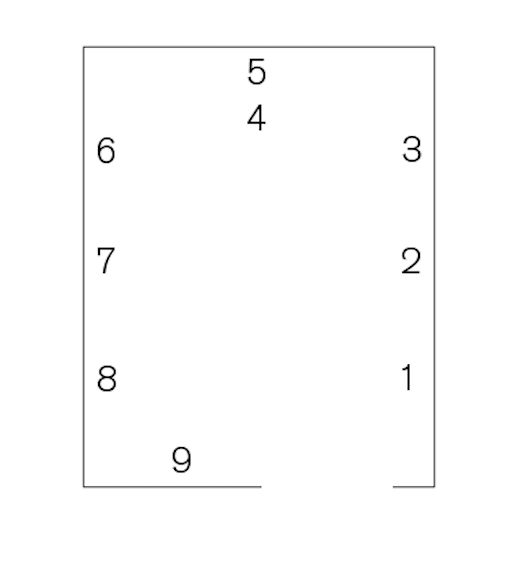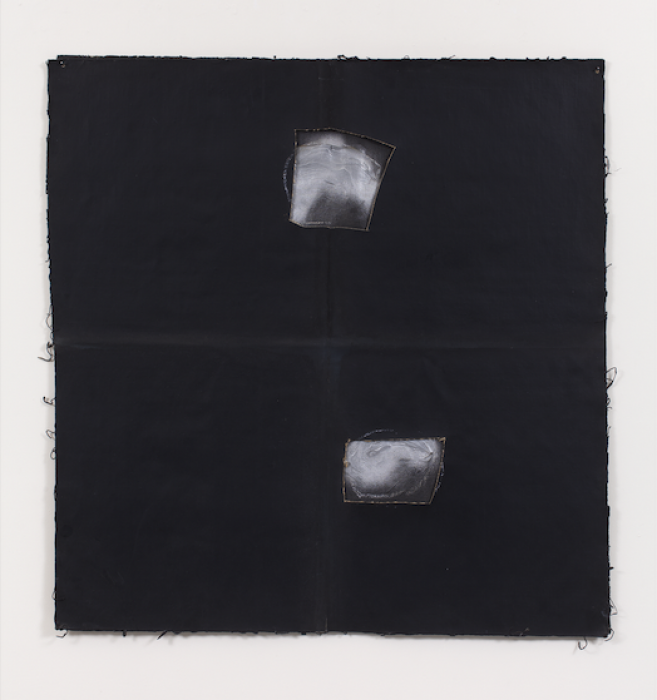Mary Heilmann: Starry Night
Long-term view, Dia Beacon
Overview
Mary Heilmann’s exhibition at Dia Beacon is the first dedicated presentation of the artist’s Starry Night series (1967–71) since its debut at Paley and Lowe Gallery in New York in 1971. For this body of work, Heilmann produced black-stained stretched and unstretched canvases referencing astronomical constellations, a group of which was bound into a large, children’s book–like work known as The Book of Night (1970), on view here. Objects made of clay and bamboo coated in flock (a type of textured fiber) complement these canvases. Leaning, protruding, or hanging high from the wall, the three-dimensional pieces bring the artist’s constructed galaxy into the space of the viewer. Through these works, Heilmann engages with formal, conceptual, and cosmological notions of light and dark, evoking constellations using cut-outs, glitter, lead foil, and other ad hoc material strategies.
Mary Heilmann: Starry Night is curated by Jordan Carter, curator and co–department head, with Emily Markert, curatorial assistant.
All exhibitions at Dia are made possible by the Economou Exhibition Fund.
Mary Heilmann: Starry Night is made possible by support from Shelley Fox Aarons and Philip Aarons and the Rennie Collection, Vancouver.
Mary Heilmann: Starry Night is the first dedicated presentation of the artist’s series of celestial works since its debut at Paley and Lowe Gallery in New York in 1971. For this body of work, Heilmann produced black-stained stretched and unstretched canvases referencing astronomical constellations, a group of which was bound into a large, children’s book–like work known as The Book of Night (1970), on view here. Objects made of clay and bamboo coated in flock (a type of textured fiber) complement these canvases. Leaning, protruding, or hanging high from the wall, the three-dimensional pieces bring the artist’s constructed galaxy into the space of the viewer. Through these works, Heilmann engages with formal, conceptual, and cosmological notions of light and dark, evoking constellations using cut-outs, glitter, lead foil, and other ad hoc material strategies.
In 1968, after completing a degree in ceramics and sculpture at the University of California, Berkeley, Heilmann arrived in New York with the goal of “getting known straight away as a sculptor.” Eager to engage with like-minded peers in the city—including Dia collection artists Donald Judd, Robert Morris, and Robert Smithson—she recalls: “When I would see [these] guys, I’d go up and say ‘hi,’ but they all threw me shade. I couldn’t get any attention for my sculpture because of the politics of the time; women didn’t really get any attention, except for a few. Also, everybody hated painting, especially me.” Heilmann quickly realized she needed to carve out a space for herself and that perhaps the best way to do so was by rebelling. In her words, “I took up painting so I could go to the hang-out places where I’d see the guys and say, ‘I’m a painter’ and cause a big argument.” Among the first works Heilmann made after moving to New York and declaring painting as her primary medium, the Starry Night canvases exemplify her distinctive painterly approach to methodologies associated with Minimal, Postminimal, and Conceptual art.
Related in part to a star-inspired work she created at Berkeley, the content and varied mediums of the Starry Night series are akin to a time capsule of a transitional yet pivotal moment in her artistic career. Her decision to leave works like Corona Borealis (1970) and Gemini (1971) unstretched and “tacked to the wall, kind of like anti-form objects” speaks to her interest in responding to her contemporaries, straddling the line between painting and sculpture. Similarly, The Book of Night hems painting into a three-dimensional object, blurring the boundaries between media and providing a haptic interface for interacting with the cosmos. Made using acrylic and oil paint, but also quotidian materials like glitter, flock, and Styrofoam—as demonstrated in the sculptural objects Starry Night (Night Sky) (1967), The Big Dipper (1969), and Sculpture of Night (1968/2007)—this early body of work is both sophisticated and DIY, presaging the way in which Heilmann’s practice would continue to unfold at the intersection of control and ease, intention and accident.
The influence of Minimal and Conceptual art on Heilmann emerges through the composition of the paintings, namely her use of the grid—intentionally imperfect, evoking an instability that alludes to the structure while resisting it. By tackling the inconceivably complex cosmos as subject matter within the regulated and finite nature of the grid and canvas, she tethers her work to the messy reality in which we can observe but not quite comprehend the universe above. Variations on the grid are a key throughline from the Starry Night series to Heilmann’s recent works, a generative framework she has loosely employed for more than five decades with increasingly vibrant and multicolored palettes. In this way, Starry Night also represents a rare, early engagement with a monochromatic black color scheme. The series thus marks the start of her lifelong interest in deploying—and deliberately deviating from—modernist tactics of composition with a dexterously inventive and energetic sensibility.
—Jordan Carter with Emily Markert

- Starry Night (Night Sky), 1967
Plywood, rayon flocking, polymer clay, and glitter
Collection the artist - Corona Borealis, 1970
Acrylic, glitter, and graphite on canvas
Collection the artist - Gemini, 1971
Acrylic and oil on unstretched canvas
Collection the artist - The Book of Night, 1970
Oil and mixed media on unstretched canvas
Collection the artist - The Great Square of Pegasus, 1971
Acrylic on canvas
Collection Cornelia McDougald, New York - Corona Borealis, 1970
Acrylic and graphite on unstretched canvas
Collection the artist - The Big Dipper, 1969
Non-firing clay, lead foil, and paint
Collection the artist - Aurora Borealis, 1971
Acrylic and glitter on canvas
Rennie Collection, Vancouver - Sculpture of Night, 1968/2007
Styrofoam, rayon flocking, and bamboo
Collection the artist
Mary Heilmann was born in San Francisco in 1940. She received a BA in literature from the University of California, Santa Barbara, in 1962, and an MA in ceramics and sculpture from the University of California, Berkeley, in 1967. Following graduate school, Heilmann moved to New York where the work and writing of artists such as Donald Judd, Robert Morris, and Robert Smithson encouraged her transition from sculpture to painting. Since then, Heilmann’s approach to painting has developed from geometric shapes to abstract forms referring to personal memory and elements derived from popular culture. Her work has been shown throughout the United States and Europe, including exhibitions at Kunstmuseum Bonn (2013), Whitney Museum of American Art, New York (2015), and Whitechapel Gallery, London (2016). From 2007 to 2009, the retrospective Mary Heilmann: To Be Someone traveled from the Orange County Museum of Art, Newport Beach, California, to the Contemporary Arts Museum Houston; Wexner Center for the Arts, Columbus, Ohio; and New Museum of Contemporary Art, New York. Heilmann lives in Bridgehampton, New York, and New York City.
Artist
Mary Heilmann
Mary Heilmann was born in San Francisco in 1940. She lives and works in Bridgehampton, New York, and New York.


